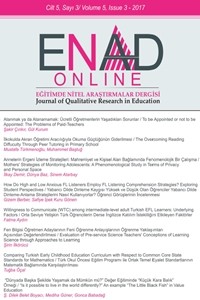Willingness to Com municate (WTC) among Intermediate - level A dult Turkish EFL Learners: Underlying Factors
Öz
The present qualitative study investigates the underlying factors of willingness to communicate (WTC) among intermediate-level adult Turkish EFL learners studying at the school of foreign languages of Anadolu University. WTC is defined as “a readiness to enter into discourse at a particular time with a specific person or persons, using a L2” (MacIntyre, Clement, Dörnyei and Noels, 1998: 547). In the current study, WTC refers to a more general willingness to participate in English lesson, communicate in English both verbally and in a written way and accordingly learn English. The participants are five students who are believed to have varying levels of WTC according to their teacher’s observation. They were told the purpose of the study and what is exactly meant by WTC. The qualitative data were collected using an open-ended questionnaire, two sessions of semi-structured interviews and six journal entries per participant. The data were analyzed using thematic analysis. Once the codes and themes were constructed and as a result the factors affecting the participants’ WTC behavior in a foreign language classroom were found, quotations were provided to support the findings. Finally, implications for teachers and administrators and suggestions for further research were propounded.
Anahtar Kelimeler
Willingness to communicate classroom participation EFL learners school of foreign language
Kaynakça
- Allwright, R. L. (1984). The importance of interaction in classroom language learning. Applied Linguistics, 5 (2), 156-171.
- Bektas-Cetinkaya, Y. (2005). Turkish College Students' willingness to communicate in English as a Foreign Language (Unpublished Doctoral Dissertation). The Ohio State University, Ohio, United States of America.
- Bernales, C. (2016). Towards a comprehensive concept of willingness to communicate: Learners' predicted and self-reported participation in the foreign language classroom. System, 56, 1-12.
- Burgoon, J. K. (1976). The unwillingness-to-communicate scale: Development and validation. Communication Monographs, 43, 60-6.
- Büyükkantarcıoğlu, N. (2004). A sociolinguistic analysis of the present dimensions of English as a foreign language in Turkey. International Journal of the Sociology of Language, 165 (1), 33-58.
- Braun V, & Clarke, V. (2006). Using thematic analysis in psychology. Qualitative Research in Psychology. 3, 77-101.
- Cao, Y. (2011). Investigating situational willingness to communicate within second language classrooms from an ecological perspective. System, 39 (4), 468-479.
- Cao, Y., & Philp, J. (2006). Interactional context and willingness to communicate: A comparison of behavior in whole class, group and dyadic interaction. System, 34 (4), 480-493.
- Creswell, J. W. (2012). Educational research: Planning, conducting and evaluating quantitative and qualitative research. Upper Saddle River, N.J.: Pearson/Merill/Prentice Hall.
- Kang, S.-J. (2005). Dynamic emergence of situational willingness to communicate in a second language. System, 33 (2), 277-292.
- Khazei, Z. M., Zadeh, A. M., & Ketabi, S. (2012). Willingness to communicate in Iranian EFL learners: The effect of class size. English Language Teaching, 5 (11), 181-187.
- Liamputtong, P. (2009). Qualitative data analysis: conceptual and practical considerations. Health Promotion Journal of Australia, 20 (2), 133-139.
- MacIntyre, P.D., & Charos, C. (1996). Personality, attitudes, and affect as predictors of second language communication. Journal of Language and Social Psychology, 15 (1), 3-26.
- MacIntyre, P.D., Dörnyei, Z., Clement, R., & Noels, K.A. 1998. Conceptualizing willingness to communicate in a L2: A situational model of L2 confidence and affiliation. The Modern Language Journal, 82 (4), 545-562.
- MacIntyre, P.D., Baker, S.C., Clement, R., & Donovan, L.A. (2002). Sex and age effects on willingness to communicate, anxiety, perceived competence, and L2 motivation among junior high school French immersion students. Language Learning, 52 (3), 537-564.
- MacIntyre, P.D., & Doucette, J. (2010). Willingness to communicate and action control. System, 38 (2), 161-171.
- MacIntyre, P.D., Burns, & C., Jessome, A. (2011). Ambivalence about communicating in a second language: a qualitative study of French immersion students’ willingness to communicate. The Modern Language Journal, 95 (1), 81-96.
- McCroskey, J.C., Baer, J.E., (1985). Willingness to communicate: the construct and its measurement. Paper Presented at the Annual Convention of the Speech Communication Association, Denver, CO.
- Öz, H., Demirezen, M., & Pourfeiz, J. (2015). Willingness to communicate of EFL earners in Turkish context. Learning and Individual Differences, 37, 269-275. Pawlak, M., & Mystkovska-Wiertelak, A. (2015). Investigating the dynamic nature of L2 willingness to communicate. System, 50, 1-9.
- Peng, J., & Woodrow, L.J. (2010). Willingness to communicate in English: a model in Chinese EFL classroom context. Language Learning, 60 (4), 834-876.
- Peng, J-E. (2012). Towards an ecological understanding of willingness to communicate in EFL classrooms in China. System, 40, 203-213.
- Riasati, M. J. (2015). Examining Willingness to Speak English in EFL Classrooms. Proceedings of the Multidisciplinary Academic Conference, 1-8. Szczepaniak, M., Pathan, H., & Soomro, N. (2013). A case study of the role of English language in Turkey. International Journal of Academic Research, 5 (5), 436-442.
- Yashima, T. (2002). Willingness to communicate in a second language: the Japanese EFL context. The Modern Language Journal, 86 (1), 54-66. Zarrinabadi, N., Ketabi, S., & Abdi, R. (2014). Facilitating Willingness to Communicate in the Second Language Classroom and Beyond. The Clearing House, 87, 213-217.
- Zhou, N. (2015). Oral participation in EFL classroom: Perspectives from the administrator, teachers and learners at a Chinese university. System, 53, 35-46.
Ayrıntılar
| Bölüm | Makaleler |
|---|---|
| Yazarlar | |
| Yayımlanma Tarihi | 30 Kasım 2017 |
| Yayımlandığı Sayı | Yıl 2017 Cilt: 5 Sayı: 3 |


